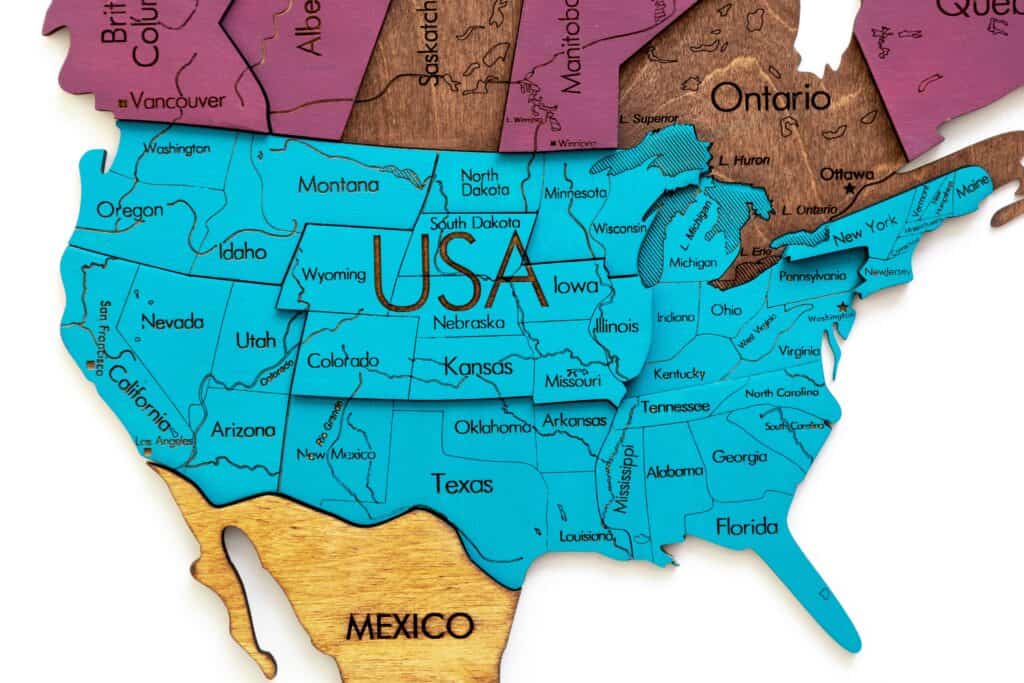Arkansas, a landlocked state in the south-central region of the United States, has long sparked debates about its classification as a Southern state. While some argue that it belongs to the Midwest or the Midsouth, others adamantly claim that Arkansas is indeed a part of the South. To better understand these distinctions, it is essential to consider the historical, cultural, and geographical factors that contribute to a state’s identity.
The United States Census Bureau and various sources define the Southern United States as encompassing Alabama, Arkansas, Delaware, Washington D.C., Florida, Georgia, Kentucky, Louisiana, Maryland, Mississippi, North Carolina, Oklahoma, South Carolina, Tennessee, Texas, Virginia, and West Virginia. Within this classification, Arkansas is recognized as part of the South. However, the diverse regional influences that shape the state’s identity make it difficult for some to pin it down to a single category.
Throughout its history, Arkansas has been influenced by a range of Southern, Midwestern, and even Western cultural elements. This unique melange makes Arkansas a fascinating mosaic, blurring the lines between regions and inviting questions about whether or not it can be definitively classified as a Southern state. Ultimately, understanding Arkansas’ place within these regional distinctions can help shed light on the broader complexity of American regional identities.

Geographic Classification
Regions and Boundaries
Arkansas, located in the south-central region of the United States, is part of the Southern United States. The United States Census Bureau defines the South as Alabama, Arkansas, Delaware, Washington D.C., Florida, Georgia, Kentucky, Louisiana, Maryland, Mississippi, North Carolina, Oklahoma, South Carolina, Tennessee, Texas, Virginia, and West Virginia. Furthermore, Arkansas is classified within the West South Central subregion, along with Texas, Louisiana, and Oklahoma. This distinction places Arkansas firmly within the definition of a Southern state.
Within the state, the geography of Arkansas can be roughly divided into two main regions: the mountainous Ozark and Ouachita regions in the north and west, and the low-lying Arkansas Delta in the east. These contrasting landscapes contribute to the state’s diverse culture and agricultural practices.
Relation to Neighboring States
Arkansas shares borders with six other states, providing connections to both the South and Midwest regions. Missouri, a Midwestern state, lies to the north of Arkansas, while Tennessee and Mississippi, both in the Southeastern United States, border Arkansas on the east. Louisiana, another Southern state, is located to the south, while Texas and Oklahoma —also considered Southern states in the West South Central subregion— can be found to the west of Arkansas.
The state’s location brings aspects from both the Southern and Midwestern regions, creating a unique cultural and geographical position within the United States. Some might argue that Arkansas is more of a midsouth state due to this mix of influences, but the generally accepted classification based on the U.S. Census Bureau places it firmly in the South.
In summary, Arkansas’ geographic classification as a Southern state is supported by its inclusion in the U.S. Census Bureau’s definition of the South and its position in the West South Central subregion. Its diverse landscapes and connections to neighboring states in both the South and Midwest contribute to its unique geography and culture.
Remember to always use the provided tone of voice: confident, knowledgeable, neutral, and clear.
Historical Context
Indigenous Peoples and Early European Contact
Before European contact, Arkansas was home to several Native American tribes, including the Chickasaw, Choctaw, Creek, Cherokee, and Seminole. The main tribe in the region was the Quapaw, who settled in the Arkansas River delta.
European explorers arrived in the 16th and 17th centuries, bringing with them new challenges. As Europeans settled the area, the Native American populations were affected by disease, warfare, and displacement.
American Revolution and Confederacy
The American Revolution saw the southern colonies, including those that would later form Arkansas, fighting against British authority. During this time, the region experienced numerous conflicts, and ultimately, the American victory laid the foundation for the creation of the United States of America.
Arkansas was admitted to the Union as a state in 1836 and later became involved in the Confederate movement in the mid-1800s. The state’s decision to secede from the Union in May 1861 was complex, but it ultimately joined the rest of the southern states in their rebellion.
Civil War and Reconstruction
The American Civil War saw Arkansas as a key battleground. The state’s location made it a hotbed for military activity, including the development of powerful fortresses like Fort Sumter. The war in Arkansas was marked by significant violence, devastation, and the struggle between the Confederate and Unionist forces. Ultimately, the Confederacy’s surrender led to the end of slavery and the beginning of the Reconstruction era.
The Reconstruction era, during which the state was required to rebuild and transform its society, was a challenging period for Arkansas. As President Abraham Lincoln and the Republican Party pushed for change, the Democratic Party in the South resisted, resulting in a complex and fraught political landscape.
Civil Rights Movement
The state of Arkansas held a prominent role in the U.S. Civil Rights Movement. A key event occurred in 1957 when nine African American students known as the Little Rock Nine enrolled at the previously all-white Central High School in Little Rock. Despite the resistance they faced, this groundbreaking act of defiance and bravery paved the way for further progress in desegregation and equal rights in the region.
In conclusion, Arkansas has a rich and complex history that has shaped its status as a southern state. From its indigenous beginnings through to the Civil Rights Movement, the state has shown a resilience and determination in the face of constant change.
Cultural Identity
Southern Culture
Arkansas’s regional identity is a blend of both the American South and Southwest regions, with its northern and western parts often characterized as “hill country,” resembling Appalachia’s culture. The culture of Arkansas is a subculture of the Southern United States, which has evolved from a mix of various European settlers’ culture, African slaves, and Native Americans .
Language and Accents
The residents of Arkansas are known as Arkansans or Razorbacks, and their speech consists of a distinct combination of numerous influences. While dialects and accents in this state may considerably vary, many residents have a Southern accent, reminiscent of other Southern states.
Bible Belt and Religious Influence
Arkansas sits firmly within the Bible Belt, an area in the United States known for its strong Christian presence. As a result, the state has a substantial influence from Christian beliefs and practices, shaping the moral values, customs, and social norms. The prevalence of religious influence can be seen in the state’s numerous churches, social activities, and community events.
Literature and Art
Arkansas’s literary and artistic contributions were significantly influenced by Southern culture, such as the traditions and folklore of the South. Iconic Southern writers, such as Maya Angelou and John Grisham, have roots in Arkansas, enriching the state’s creative and literary history. In addition, regional art exhibits showcase the state’s connection to Southern culture and the unique lifestyle found in both the rural Arkansas delta and the southern regions.
Economic Factors
Agricultural and Industrial History
Arkansas has a long history of being influenced by Southern traditions, which includes its agricultural and industrial roots. The state’s fertile soil and timber resources played a crucial role in drawing settlers to the region, mainly from other Southern states, enhancing Arkansas’s connection to the South. Cotton production, a significant economic driver in the Southern states, was prominent in the Arkansas Delta region.
Contemporary Economy
Over the years, Arkansas has diversified its economy in various sectors while preserving its agricultural roots. According to the United States Census Bureau, the state’s gross domestic product (GDP) was $119 billion in 2015. Walmart, one of the world’s largest companies, is headquartered in Arkansas.
The federal government acknowledges Arkansas as a Southern State, and it is grouped alongside other states such as Alabama, Georgia, and Mississippi. The state’s economy continues to evolve, with new industries such as technology playing a more significant role. While it is important to acknowledge the historical factors that influenced Arkansas’s economic position as a southern state, it is also crucial to recognize the contemporary forces impacting its economic climate.
Demographics
Population Distribution
Arkansas is a landlocked state in the south-central region of the Southern United States, bordered by Missouri to the north, Tennessee and Mississippi to the east, Louisiana to the south, and Texas and Oklahoma to the west. According to the 2020 United States Census, Arkansas had a population of 3,011,524. The majority of the population resides in urban areas such as the capital city, Little Rock, located on the banks of the Arkansas River.
Ethnic and Racial Composition
The racial composition of Arkansas is diverse, with the 2020 Census stating that 70.2% of the population is White American, 15.1% Black or African American, 0.9% American Indian and Alaska Native, 1.7% Asian American, 0.5% Native Hawaiian and Other Pacific Islander, 4.5% from Some Other Race, and 7.1% from Two or More Races2. The Mississippi Delta region, in particular, has a significant African American population that can be traced back to the time of the Jim Crow laws.
Urban and Rural Areas
Arkansas’ landscape is divided into several subregions, including the Ozark Mountains in the north, the Arkansas River Valley, Ouachita Mountains, and the Mississippi River plain that encompasses the Mississippi Delta region in the east. While the state is primarily rural, there are several urban centers such as Little Rock and smaller towns throughout the state. The vast majority of the population is concentrated in the metropolitan areas, whereas rural areas experience a lower population density.
Arkansas exhibits the typical characteristics of a Southern state both in terms of demographics and cultural aspects. This, combined with its location in the south-central region of the United States, further substantiates its status as a Southern state.







